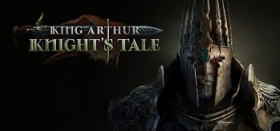
King Arthur: Knight's Tale Preview
I'm an Arthurian legend nut. Anything that involves King Arthur, Camelot, Avalon, and the Knights of the Round Table, I'm sold on. So imagine my surprise when I found out that King Arthur: Knight's Tale existed.
Sporting a unique twist to the story, you will be taking the role of Sir Mordred on his quest to assassinate King Arthur after the events that unfold throughout the legend. The preview begins with a gorgeous cinematic depicting everything that transpired prior to the events of the game, including the final battle between Sir Mordred and King Arthur as they both strike each other down. The Lady of the Lake tells that after King Arthur was felled, and his lifeless corpse was dragged to Avalon, he arose as a wraith-like creature that raised the dead, wreaking havoc in his wake. In a desperate attempt to stop King Arthur's reign of terror, the Lady of the Lake decides to trust fate once more and resurrected Sir Mordred from the grave in hopes that he would fulfil his destiny: kill King Arthur.
An interesting premise that immediately had me hooked, if not only for the gorgeous cinematic, presentation, and music that played throughout the title screen. It is at this point that Sir Mordred awakens, and you are now able to control him.
The tutorial is quick and easy, although the game could certainly use a bit more tutorials to explain the more in-depth combat mechanics, including the overwatch and resting systems present in the game that both use some of your action points. Although the combat is not complex for the standards of strategy games, King Arthur: Knight's Tale has some systems that I was deeply appreciative of that allow for more in-depth battle mechanics, which will surely help in the hard difficulties.
The tutorial sequence is easy, which will also introduce another Round Table knight trapped within the basement of the castle, as this doubles as a tutorial for how you — as the player — can interact with the numerous knights present throughout the game and choose what kind of person Sir Modred grows to be. Although I wish throughout the earlier stages Sir Mordred acted less like an almighty villain that acts the way he does just to spite people, the option to play either a nicer or meaner version of the character was a sincerely welcome addition I was not expecting.
As you select dialogue options, Sir Mordred's morality changes accordingly. The two polar opposites of the vertical line are the Righteous and Tyrant moralities, which is dictated by how just or tyrannical he acts as a king. As for the horizontal line are the Old Religion and Christianity beliefs, which are dictated by whether you allow Sir Mordred to follow the new faith King Arthur tried to set out for Camelot, or follow the ways of the past. These aren't just for show either, as leaning too far into some of the sides will raise and lower the loyalty some knights have, whilst also unlocking unique characters according to which one you follow; at the far side of the Old Religion, you get to unlock Morgan le Fay!

As for the combat, the game features turn-based, strategy combat in which players will control several knights and command them throughout the battlefield. Since this is an era of medieval times and magic, the number of weapons (and thus classes) present throughout the game is wide, including mages, archers, heavy two-handed wielders, dual-wielders, and sword-and-shield wielders. The game features a dual HP bar mechanic in which each character can take damage to their "armour" that can be healed while resting on a campsite, or to their "vitality' that requires them to be left to heal in the infirmary; should a knight perish in battle, they are gone forever (this doesn't apply to the easy mode). Featuring backstabs, resistances, armour that prevents damage points, and status effects, there is always going to be a lot of things to focus per battle sequence.
One mechanic within the combat system that I wasn't entirely sure how to feel about was how the movement and attacks work. Instead of having a separate action point to ensure every character can attack throughout their turn, every action drains from your total action points, which are used for movement, buffing, and overwatch. This mechanic made me choose constantly between whether I wanted to use all of my action points to move towards the enemy or move forward and save the rest for later. Each unit within the battlefield moves slow and heavy — you can't move two characters at the same time, meaning you'll be waiting for them to finish moving before you can mobilise another. This also applies to the enemy; however, their turn can be sped up by holding down the spacebar: a handy feature to ensure that I can watch closely whenever necessary without having to delve into the settings.
King Arthur: Knight's Tale has a lot of potential within it. It is undeniable that some of the knights (namely Sir Mordred) have more of a one-dimensional personality earlier on, although selecting which ways he reacts and what he does did remedy this problem. Should the developers continue down this route, it is definite that King Arthur: Knight's Tale will be successful, especially with the promised continued support.

King Arthur: Knight's Tale will release on the 29th of March on PC, with the Xbox Series X|S and PlayStation 5 versions coming at a later date.












COMMENTS